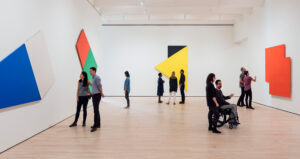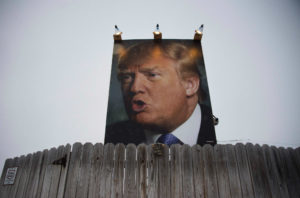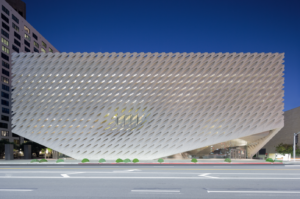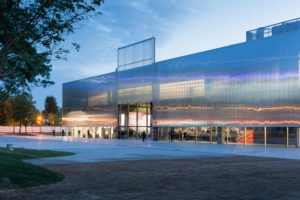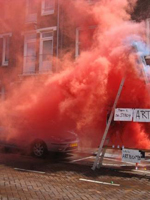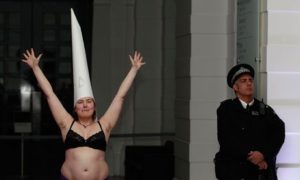Helen and Charles Schwab Director of SFMOMA Neal Benezra opened the day of panel discussions on January 13, 2017, with a fond word for Phyllis Wattis, benefactor of the lecture series, citing her as the paradigmatic example of what we were all there to discuss: partnerships between public museums and private benefactors. The symposium’s four panels featured a star-studded lineup of museum directors and chief curators from around the globe who had come to talk about the fraught issue of private versus public in the museum world.
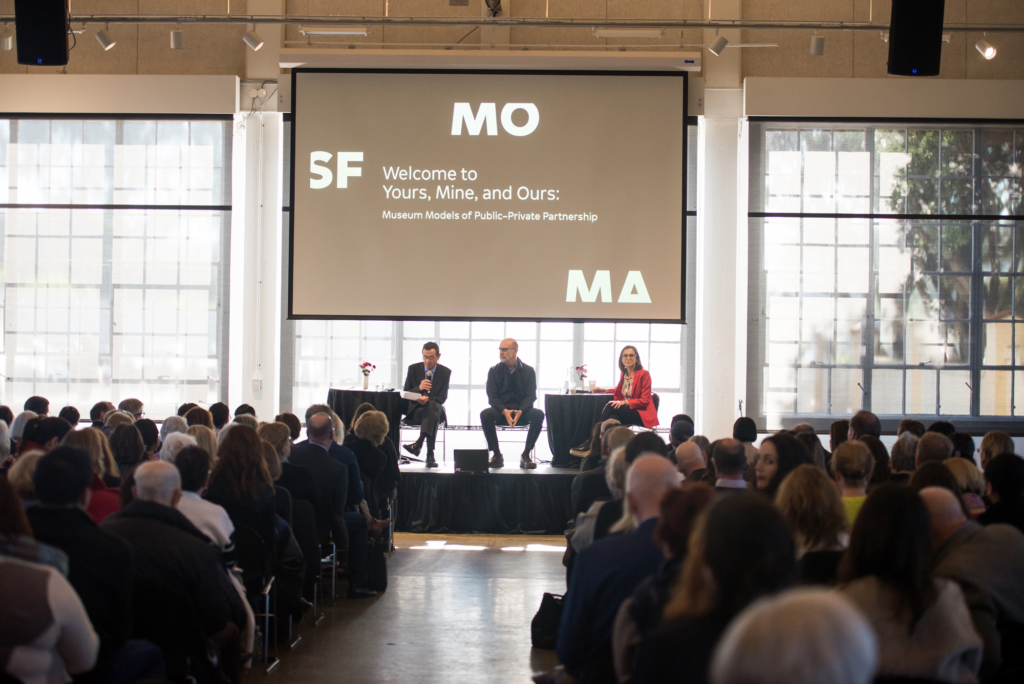
Neal Benezra, Robert Fisher, and Sarah Thornton at Yours, Mine, and Ours; photo Beth LaBerge, courtesy SFMOMA
American culture tends to take a fatalistic attitude toward private influence over the public sphere. We are conditioned to feel that it shouldn’t happen, but we know that it does happen all the time, at every level. What we discovered by the end of the day, however, is that most museums would never have been “born” had it not been for private individuals — often a single person — with a driving vision to share their art collection with the wider world. And since the vast majority of American museums do not take in enough money in ticket and museum store sales, or from local and national governments, to sustain themselves, they couldn’t continue to function without the constant involvement of wealthy and powerful people on their boards of trustees, keeping one another excited and engaged about fundraising and growing the collection.
How did the partnership between SFMOMA and the Fisher Art Foundation take shape?
Moderated by author and professional art-world insider Sarah Thornton, the first panel featured Neal Benezra and Bob Fisher, president of SFMOMA’s Board of Trustees. They began with an outline of the 2009 agreement in which the Fisher Art Foundation, an entity created by the Fisher family, loaned its incredible collection of modern and contemporary art to SFMOMA for one hundred years, with the option to extend the loan in twenty-five-year increments thereafter. Every ten years, an exhibition of exclusively Fisher works must be mounted in the new part of the building on floors 4, 5, and 6. The rest of the time, those galleries must contain at least 75 percent Fisher works.
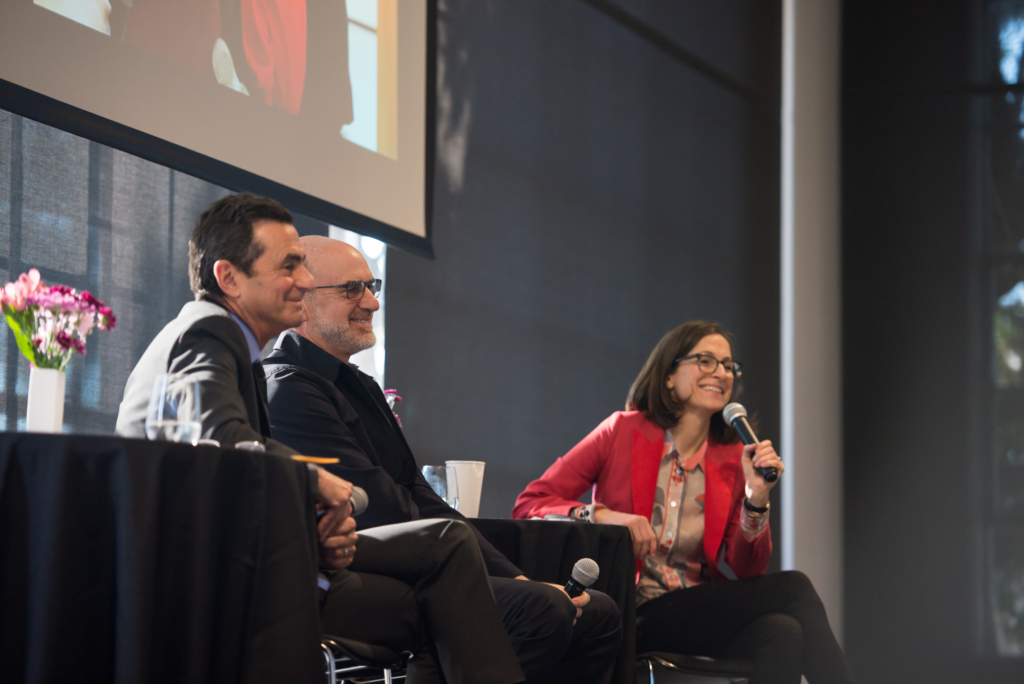
Neal Benezra, Robert Fisher, and Sarah Thornton at Yours, Mine, and Ours; photo Beth LaBerge, courtesy SFMOMA
Even non-curators might immediately see some potential issues there related to the curtailment of curatorial freedom. But Benezra headed those arguments off at the pass. First, the Fisher collection is incredibly rich in great material, hardly leading to a reduction of options. Second, to focus on the agreement terms misses the real point: “What matters is not the contract, but whether the art will age well. The Fishers collected in depth on artists they committed to. We placed a bet that in fifty years Agnes Martin, Anselm Kiefer, Ellsworth Kelly, and so on will still be key artists. They will define late twentieth-century art. If we’re right, we’ll have made a good deal and we’ll have done the right thing by San Francisco.”
The fact that the collection was amassed by two individuals with particular tastes — his parents, who were also very involved with SFMOMA — is a good thing, according to Fisher. It makes the collection interesting and different, and because of its specific idiosyncrasies — namely that the Fishers collected particular artists in depth — visitors can see not one or two, but many works by a single artist, all together in a room. “New York has amazing Abstract Expressionist art, but if you want to see Jackson Pollock, you’ll only find maybe one or two pieces at any one museum. We can tell a different story here. Visitors can see four or more paintings by Cy Twombly, Brice Marden, Chuck Close. If you want to see a great Chuck Close presentation, you now can in San Francisco.”
Fisher also noted that this massive long-term loan inspired other collectors to donate generously — to the tune of three thousand additional artworks. “The Collections Campaign was a story that came across well to the community. People embraced it. SFMOMA was able to approach collectors and say, for instance, ‘We don’t have a Gerhard Richter stripe painting, so if you give it, it definitely will be shown.’”
Is there an “American model” of public-private partnership?
The next panel concerned the American model of public-private partnership in the arts. It featured Agustín Arteaga, director of the Dallas Museum of Art, formerly director of several different institutions in Latin America; Joanne Heyler, founding director and chief curator of the Broad in Los Angeles; and Max Hollein, director of the Fine Arts Museums of San Francisco, formerly director of Frankfurt’s Schirn Kunsthalle. Dominic Willsdon, SFMOMA’s Leanne and George Roberts Curator of Education and Public Practice, moderated.
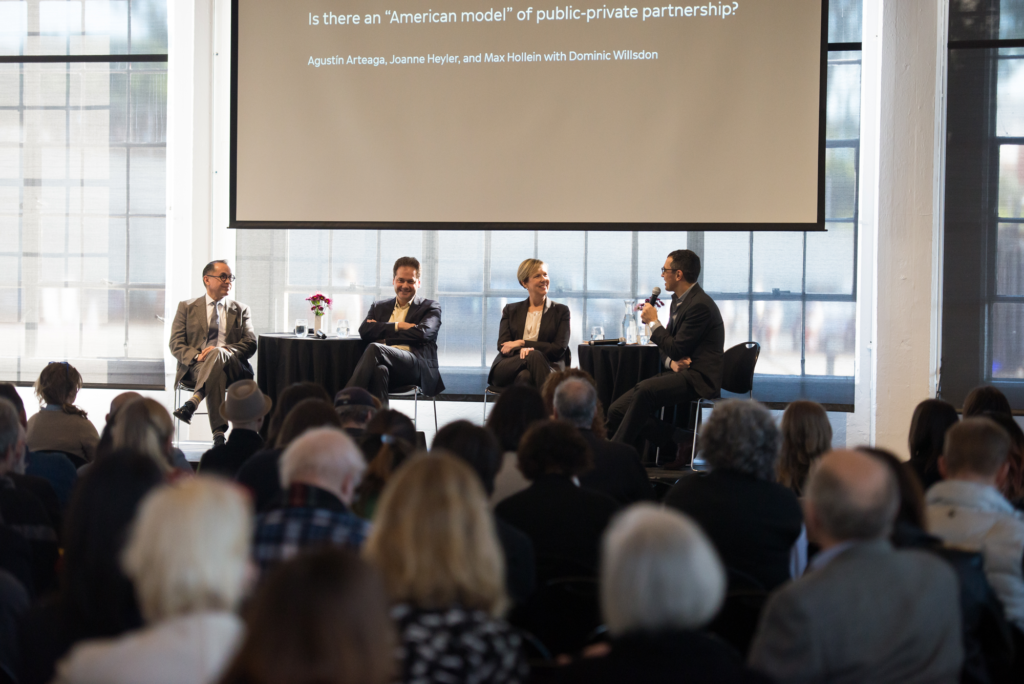
Agustín Arteaga, Max Hollein, Joanne Heyler, and Dominic Willsdon at Yours, Mine, and Ours; photo Beth LaBerge, courtesy SFMOMA
Hollein, who has experience in both the United States and Europe, seemed to prefer the situation in the States: “At a classical European museum, the board consists of government officials. At American institutions, the board is all entrepreneurs. In Europe, the board meets once a year and the primary goal is to make sure the museum director doesn’t ask for more money from the government! Here, the board is deeply involved in the day-to-day workings, and they’re constantly asking, ‘What can we do next?’ Everywhere in this country museums are opening and expanding, so there is obviously a lot of energy and positive dynamics.”
This also means, he added, that unlike in, say, France, the inauguration of a new president who is not so into the arts will have a negligible impact on museum operations throughout the country.
Arteaga agreed that the “active” American model of the board of trustees can be a great thing — “They’re not only fundraising, but working on committees, sharing responsibility, and giving their time and expertise for the good of the institution” — but noted that it only works when everyone is “all in.” He recalled the time between the 1980s and 2010 when many museums expanded and then had a severe crisis because of insufficient planning.
This led naturally to an interrogation of the youngest museum in the group, the Broad, which opened to the public in September 2015. Willsdon asked Heyler if perhaps the Broad is an infant version of the Guggenheim, the Frick, or the Phillips Collection. She replied that indeed, all of those institutions “crossed over” after their donors’ lifetimes from being an individual private museum to something else much bigger and more public-minded. “Before the launch, I got asked a lot about why Los Angeles needs another art museum. I couldn’t have predicted that we’d see a million visitors already. I don’t think attendance is the only measure of success in our field, but we had standby lines around the block four hours in duration over the holidays. We are fully endowed, and the collection is stable.” The Broad, she is certain, will endure.
It’s also committed to free general admission. “It allows us to focus on the public purpose. It’s brought a new young audience into contact with contemporary art. I’m hoping that what we’re seeing at the Broad will apply a certain amount of healthy pressure to all museums to find ways to bring in the young audiences we have.”
All of the panelists stressed the need for culture not just in big cities, but in the hinterlands as well, and Hollein and Arteaga both noted that when your government is assisting with funding, that becomes easier to do. “The government public funding of culture in Germany and the UK creates a very dense cultural infrastructure in places where there’s no wealth being accumulated,” noted Hollein. Arteaga explained that at the Dallas Museum of Art, the city owns the building, which means that getting basic repairs done can be frustrating, but at least they don’t have to pay for heat or rent. “To me,” he said, “the ideal is to have a balance of private and public funding, like the Tate. They have support from individuals and corporations.”
Arteaga added: “We made an important change in 2012 when we decided to make admission free. It had an impact on our logic. We are now reaching all communities in the city, which means we’re doing our job better.”
Kim Sajet, director of the Smithsonian National Portrait Gallery, was in the audience, and noted that while it’s great to have governmental support, it leaves you open to meddling. “We had a stink recently because they told us to take something down. Although from what I’ve seen that doesn’t happen so much in European countries.” Hollein confirmed that “German politicians are opinionated, but there’s a clear division there. Nevertheless, any kind of setup has its influences. Just as the Fisher family influenced SFMOMA in a major way, there’s always the media, the government, and so on. You need healthy relationships, healthy management, and you have to draw clear lines.”
How are public-private partnerships developing differently beyond the United States?
The third panel featured Kate Fowle, chief curator of the Garage Museum of Contemporary Art in Moscow and director-at-large of Independent Curators International, formerly international curator at Ullens Center for Contemporary Art in Beijing; and Lars Nittve, until recently executive director at M+, a new museum being created in Hong Kong, and formerly director of Tate Modern in London and the Moderna Museet, Stockholm. The panel was moderated again by Sarah Thornton.
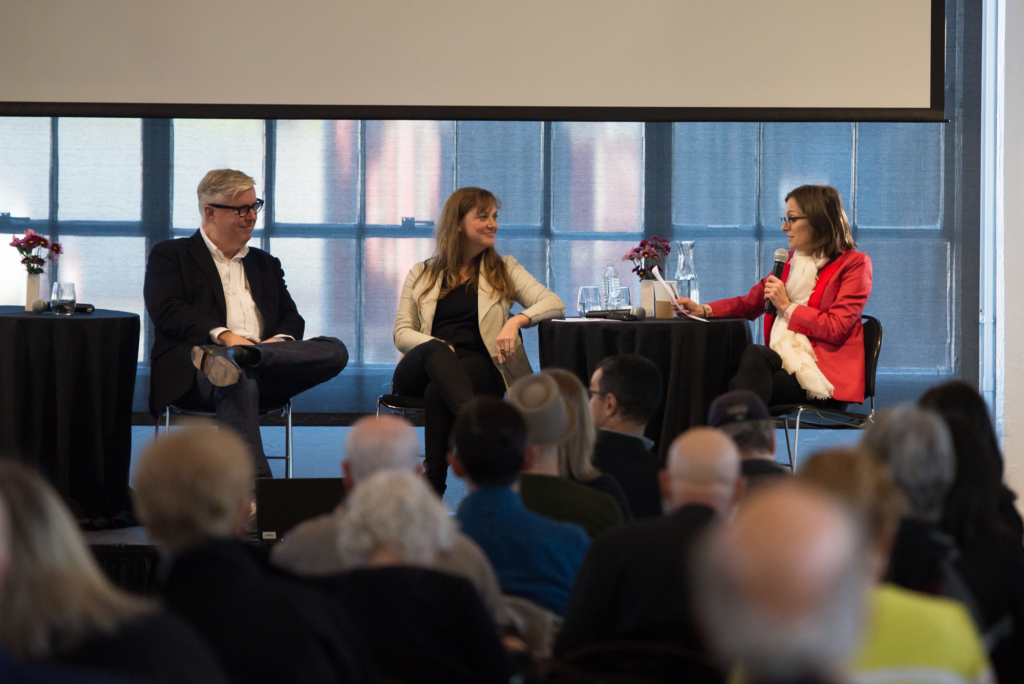
Lars Nittve, Kate Fowle, and Sarah Thornton at Yours, Mine, and Ours; photo Beth LaBerge, courtesy SFMOMA
The thrust of this panel was to hear from individuals working outside the Western model. Fowle noted with a bit of discomfort that she and Nittve were both Western Caucasians, but it did mean that they could offer perspectives based on deep experience regarding the differences between East and West when it comes to founding museums and heading them up.
Nittve started out with a definition of the terms at stake: public versus private. “The most common way of defining that is where the money comes from. And according to that measure, SFMOMA and most other museums in the United States are private. But that is not really central. What’s central is whether you see yourself as having a public service role. Garage [Fowle’s institution] is single-family-started, but it’s the most public-service museum in Moscow, maybe in all of Russia. It does publications, education — the whole program is about public service. You could say the same thing about the Broad. It’s what role you take on.”
Fowle made the key point that “public” and “private” in relation to the state mean very different things outside the West. “In Russia and China, if something is state-run, it doesn’t mean it’s publicly minded or in the public interest.” And this applies as well to notions of civic responsibility: “The ‘civic’ is not the same when you’re in a situation where the state is not thinking in the public interest, but in its own interest. And then the word ‘private’ becomes slippery, too, when you’re in a place where the notion of the ‘private’ individual doesn’t exist, or didn’t until recently. People in Russia and China didn’t have private wealth. So then to think of a partnership between public and private gets even more complicated.”
Nittve told the dramatic story of having been approached by a high government official in Hong Kong seven years ago, offering him the principal job of heading up an effort, funded to the tune of one billion US dollars, to “create the museum that Asia doesn’t have.” “They wanted something that would set the standard, like the Pompidou or MoMA. It will open in 2019. The categories it’s using for art, architecture, and design are different from in the West because practitioners in Asia move more freely between these roles. So the museum will be one of ‘visual culture.’ Like other modern and contemporary art museums it looks at the world of the last seventy years, but it’s from where it is standing, in Hong Kong.” (A major portion of the initial collection will come from a single person, Uli Sigg, a Swiss collector who lived in Asia for many years.)
Nittve noted that this project could never happen in mainland China, because of the censorship, whereas in Hong Kong “there would be demonstrations if the government was perceived as restricting free expression.” Also, “The other museums in Asia are all about the national story. Hong Kong is the only place in Asia where you’re liberated from those nationalistic things and can tell a pan-Asian story.”
Fowle had fascinating things to say about starting a museum of contemporary art in Russia, not least the fact that there’s no Russian word for “contemporary art.” There it’s called “actual art” for reasons related to decades of suppression and censorship. “Contemporary art in Russia started in 1981 or so. Underground art started around 1960. It was not legal or public in any way. Exhibitions happened in people’s studios. So the public has no tradition of taking their kids to see contemporary art — no tradition of public-ness in art in general.”
“Garage isn’t trying to ‘get people into contemporary art.’ We’re trying to get people into this thing that they like coming to see, and it looks like art and it is art, but we’ll give it a name later. They just need to get used to a place that has a public-ness and feels like it’s theirs.” She also stressed the unusual overlap between “archive” and “collection” in Russia, since so many things were destroyed or have left the country. The history of Russian art production has to be told as much through traces as through actual-original objects.
What is the future of the public?
The final panel, on the slippery definition of “the future of the public,” featured Frances Morris, director of Tate Modern in London; Richard Armstrong, director of the Solomon R. Guggenheim Museum and Foundation; and Manuel Borja-Villel, director of the Museo Nacional Centro de Arte Reina Sofía in Madrid. It was moderated by Dominic Willsdon.
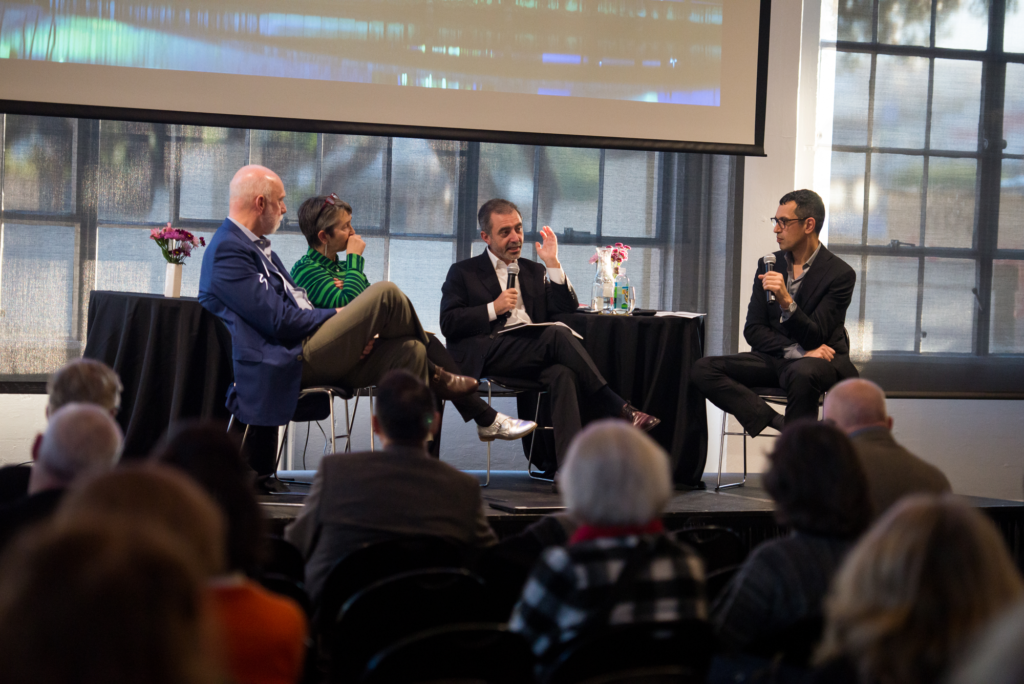
Richard Armstrong, Frances Morris, Manuel Borja-Villel, and Dominic Willsdon at Yours, Mine, and Ours; photo Beth LaBerge, courtesy SFMOMA
Armstrong explained how “public” varies in definition and practicalities across the countries in which the Guggenheim has museums [currently the United States, Spain, and Italy, with another one under construction in the United Arab Emirates]. “There’s very little participation of the Italian government, like less than 1 percent. However, the minister of culture is the technical guardian of the collection, and we need his permission to borrow one of our own works. In Spain we’re incorporators of the museum with the city and regional government. That’s the only place where I interface with politicians. Although right now, the government there is quite good. In New York, we want to be civic minded, but we get less than $250,000 out of a budget of $50 million from Washington DC. There, I find politics deeply unrewarding.” [audience laughter]
Borja-Villel told the sad story of museum funding in Spain. For a long time, the Reina Sofía was 95 percent government funded. Then after the economic crisis of 2008–9, that funding was cut by nearly half in two years. Imagine the pressure, he said, that put on the museum to suddenly start fundraising from new sources. “Yet still in our bylaws we are mandated to ‘represent contributions of Spanish art in the twentieth century.’ That mandate has a national element. But the idea of the Spanish public has not always been the same. We represent people who couldn’t write their own history because they had no territory. So that means that one of the basic things that we do recently is to question this idea of the public, the national.”
“All of us on stage today have a strong public commitment,” said Morris. “The difference is that all of us see a gap between those who pay and those who decide. We need to keep a distance between what we do and the marketplace: corporate sponsorship, philanthropy, et cetera. We have a duty to continually question our own methodologies.” She recalled discussions with the artist Philippe Parreno, whom Tate commissioned to do a major site-specific work for their (corporate-sponsored) Turbine Hall. “He described the work as creating for the visitor an experience like going to a public park. I love this metaphor of the museum as a civic space that is full of experiences that one can have in public or private terms.”
Borja-Villel recalled a strange disagreement he’d had with a journalist recently. Some shows and certain days at the Reina Sofía are free, and apparently the journalist complained that those visitorship numbers were “fake” because the visitors were not paying. “The idea of ‘public’ means democracy. We have to build on it, work on it. Museum directors have an obligation to create a dynamic that is always changing. Not all publics are the same. You have to cultivate publics, counter-publics. The latter need a voice, a space.”
“This seems key,” Willsdon responded, “the idea that the public is divided. The museum space must accommodate a contest of ideas, and not see visitors as a sum of happy consumers.”
“At the opening of the new Tate Modern,” Morris recalled, “we had a day of people demonstrating for arts education in UK schools. Twenty-four hours later, we had another group protesting about the death of Ana Mendieta.” And then there was the famous instance of visitors spelling out “BUSH GO HOME” with their bodies during Olafur Eliasson’s The Weather Project installation in Turbine Hall in 2003, which made international news.
If you open yourself up as a civic space, in other words, it’s a place where ideas can be presented and contested whether you endorse them or not. In the days leading up to Brexit, remembered Morris, “Someone projected ‘Vote Remain’ onto the building even though Tate is legally not allowed to take sides in politics. Yet we’re still a [literal] blank canvas. We’re open to debate.”
